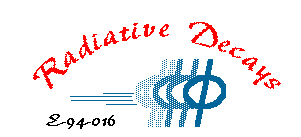



November 17, 2001
Jefferson Lab
Newport News, VA
Motivation: It is now a little over a year since our last formal Collaboration Meeting (UConn, Sept 30 2000) where we kicked off the Radphi physics analysis. The goals of that meeting were to designate the computer resources needed to carry out the analysis and to lay out a road map for the following few months. For computer resources we decided to concentrate on the I.U. and UConn clusters, and to work in ways that exploit the complementarity between them. For a road map, we delineated three major phases in preparation for physics analysis:
Our experience over the last year has also highlighted some big challenges that stand between us and a physics result, namely the b1 and manpower. There may be other mesons (eg. eta(1295), pi(1300), f1(1285), ...) whose photoproduction cross sections are unknown that contribute to our 5gamma background under the phi, but right now we know the b1 is there and it is large. In the present eta,pi analysis, the feedthrough into 3gamma from 5gamma b1 decays produces a background at the mass of the phi that is just as big as the phi->eta,gamma. This is the largest all-neutral branch of the phi, about 2 orders of magnitude larger than the rare decays of interest. Beating this background is our major challenge, and is where our efforts are concentrating at present. At the same time, we are keeping an eye on the question of what outcomes we can realistically expect from this analysis and be prepared to redirect our efforts accordingly. All of us are aware that we have a limited amount of analysis effort available, and with it we want to maximize the physics impact.
Objectives: We should accomplish at least the following three things
at this meeting: (a) review what we know about the dominant backgrounds in
phi decay channels and why our present analysis fails to suppress them,
(b) identify key unexploited features of the data which distinguish signal
from background and study how best to extract them, and (c) decide on a
common set of criteria and plan a short list of studies to test how well
these ideas work. If a clear resolution emerges from the discussion these
matters then discussion will proceed to a set of checkpoints for evaluating
our progress towards finding the phi in 5gamma.
Time:
9:30am - 5:00pm on Saturday, November 17.
Place: CEBAF Center conference room B207.
Agenda:
The following is a broad outline, meant to more as a guide than a
strict schedule.
| 9:30 | R. Jones | Overview and objectives |
| 10:00 | M. Kornicer | Phi signal and background in 3gamma |
| R. Jones | Phi signal and background in 5gamma | |
| Discussion | Key backgrounds and their signatures | |
| 11:00 | S. Teige | Current algorithm for the CPV coincidence |
| Discussion | Plan to study and implement an optimized CP veto | |
| 11:45 | C. Steffen | Current algorithm for the BSD-tagger coincidence |
| Discussion | The best way to use the BSD/tagger timing | |
| 12:30 | lunch | |
| 1:30 | P. Rubin | Preparations for a NIM article on Radphi | Discussion | Collaboration matters: spokesmanship, other physics, future possibilities in Hall B |
| E. Smith | Review of disassembly procedures and equipment recovery | |
| 2:30 | D. Armstrong | Optimization of the LGD clustering algorithm |
| Discussion | Criteria for LGD clusterizer optimization | |
| Discussion | What is the best use of the BGV? | |
| 3:30 | R. Jones | Summary of methods and criteria for effectiveness |
| Discussion | Working groups and assignments | |
| 4:00 | R. Jones | Monte Carlo: what we need to answer questions over the next 6 months |
| 4:30 | Discussion | Evaluation of conference calls, next collaboration meeting |